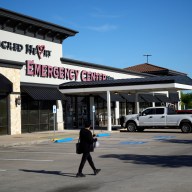By Lucia Mutikani
WASHINGTON (Reuters) – U.S. employment rose more than expected for the second month in a row in July and wages picked up, bolstering expectations of faster economic growth, and raising the probability of a Federal Reserve interest rate increase this year. Nonfarm payrolls rose by 255,000 jobs after an upwardly revised 292,000 surge in June, with hiring broadly based across the sectors of the economy, the Labor Department said on Friday. In addition, 18,000 more jobs were created in May and June than previously reported. Economists polled by Reuters had forecast payrolls increasing 180,000 in July and the unemployment rate dipping one-tenth of a percentage point to 4.8 percent.
The unemployment rate was unchanged at 4.9 percent as more people entered the labor market.
Highlighting job market strength, average hourly earnings increased a healthy eight cents and are up 2.6 percent year on year, while workers put in more hours.
“The July jobs report was everything you could have asked for and more. Provided the strength in jobs is confirmed with other economic data, the Fed will have sufficient reason to hike (rates) this year,” said Michelle Meyer, a senior economist at Bank of America Merrill Lynch in New York. The U.S dollar <.DXY> rallied against major currencies after the data, while yields rose on U.S. government debt as traders ramped up bets for an eventual Fed interest rate rise.
U.S. stocks notched their best day in a month on Friday, with the S&P 500 <.SPX> and Nasdaq <.IXIC> indexes both closing at record highs. [.N]
The signs of labor market strength, particularly the pickup in wage growth, could become a factor in the U.S. presidential election in November, given voter frustrations with an economic expansion that has left many Americans behind. U.S. Republican presidential nominee Donald Trump plans to lay out his economic vision in a speech on Monday.
FED INTEREST RATE RISE SEEN MORE LIKELY
Last month’s strong jobs growth should reinforce the Fed’s confidence in a labor market that officials view as at or near full employment. Fed Chair Janet Yellen has said the economy needs to create just under 100,000 jobs a month to keep up with population growth. The U.S. central bank raised interest rates for the first rise in nearly a decade last December, but since then has held rates steady amid concerns over persistently low U.S. inflation and a global economic growth slowdown. Given lingering global uncertainties and the upcoming U.S. presidential election, most economists expect another interest rate increase only in December, but financial markets are less sure.
After Friday’s data, Fed futures contracts were pricing in about a 46 percent chance of a rate hike by the end of this year, up from about 34 percent.
However, more top Wall Street banks now expect the Federal Reserve to raise U.S. interest rates in 2016 after Friday’s jobs report, a Reuters poll conducted on Friday showed.
Of 21 primary U.S. Treasury dealers who do business directly with the Fed, 13 said the U.S. central bank would raise its target interest rate by a quarter percentage point by the end of the year, compared with 8 of 15 primary dealers in a July 8 poll. Three of the banks polled said the Fed would raise rates at its Sept. 20-21 meeting, a slight shift from a month ago when none thought the Fed would make such a move.
“December is definitely in play,” said Justin Lederer, Treasury strategist at Cantor Fitzgerald, one of the 23 primary dealers, in New York.
RISING WAGES
Last month’s 0.3 percent increase in average hourly earnings left the year-on-year gain at 2.6 percent. The average workweek increased by 0.1 hour to 34.5 hours in July, the most since January. With both hours and hourly earnings rising, workers’ take-home pay shot up 0.6 percent. “Businesses are still willing to invest in labor and pay higher wages to retain employees. The combination of strong employment and firming wage growth should remain supportive of income and consumer spending,” said Greg Daco, head of U.S. macroeconomics at Oxford Economics in New York. The payrolls data added to July auto sales in underscoring the economy’s sound fundamentals. The Atlanta Fed is currently forecasting GDP growth accelerating at a 3.8 percent annualized rate in the third quarter, after averaging a tepid 1.0 percent in the last three quarters. But with the bulk of labor market slack largely absorbed and the economy’s recovery from the 2007-2009 recession showing signs of aging, payroll gains will probably drift lower over the next 12 months, economists say. “While a maturing labor market will translate into lower job creation over the next twelve months, reduced labor market slack should provide an offset through stronger wage growth,” Daco said. Manufacturing sector employment increased by 9,000 jobs in July after adding 15,000 positions in June. Construction payrolls rose 14,000 following three consecutive months of declines. Mining shed a further 7,000 jobs in July. Professional and business services, a high wage sector, added a strong 70,000 jobs last month, the most since last October. Retail sector employment increased by 14,700 jobs and payrolls in the leisure and hospitality sector rose by 45,000. Temporary-help jobs, a harbinger of future hiring, increased 17,000. Healthcare and social assistance payrolls rose by 48,800 jobs, extending the prior month’s hefty gains. Government employment increased by 38,000 jobs as state and local authorities stepped up hiring of teachers. Other details showed a rise in the labor force, which lifted the participation rate, or the share of working-age Americans who are employed or at least looking for a job, by one-tenth of a percentage point to 62.8 percent. The employment-to-population ratio increased to 59.7 percent from 59.6 percent in June.
But a broad measure of unemployment that includes people who want to work but have given up searching and those working part-time because they cannot find full-time employment rose one-tenth of a percentage point to 9.7 percent last month. (Reporting by Lucia Mutikani; Editing by Tim Ahmann and Paul Simao)















